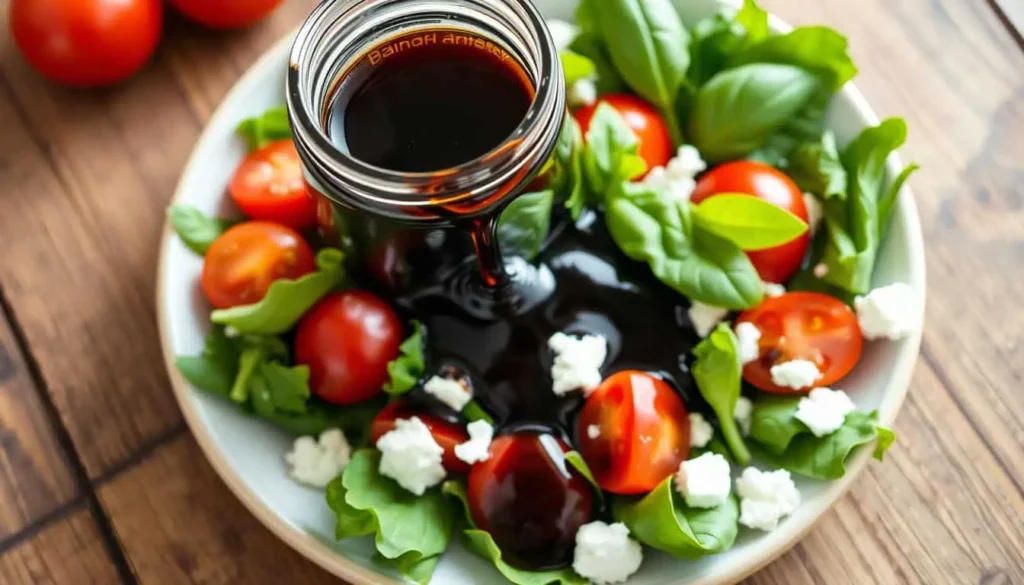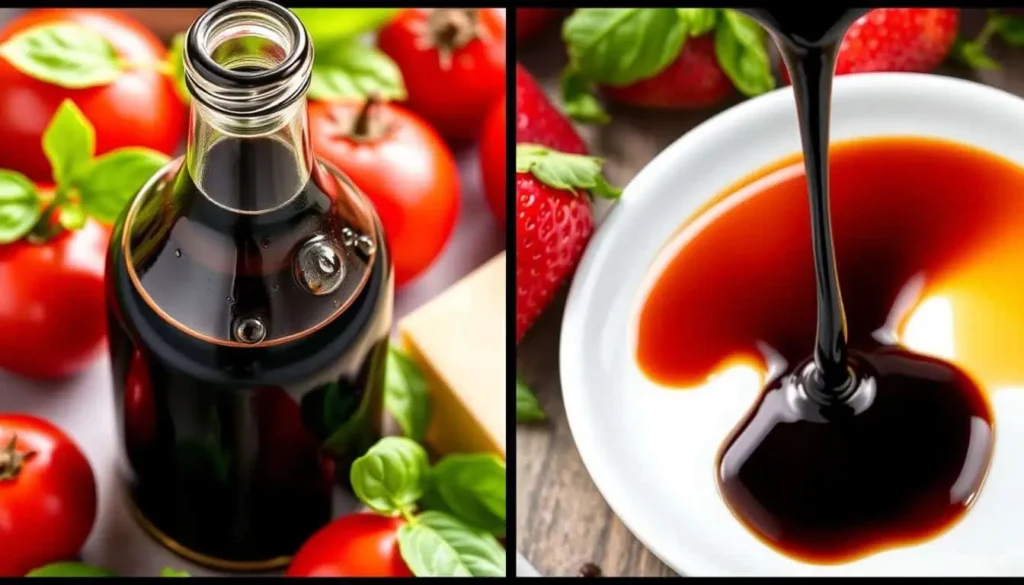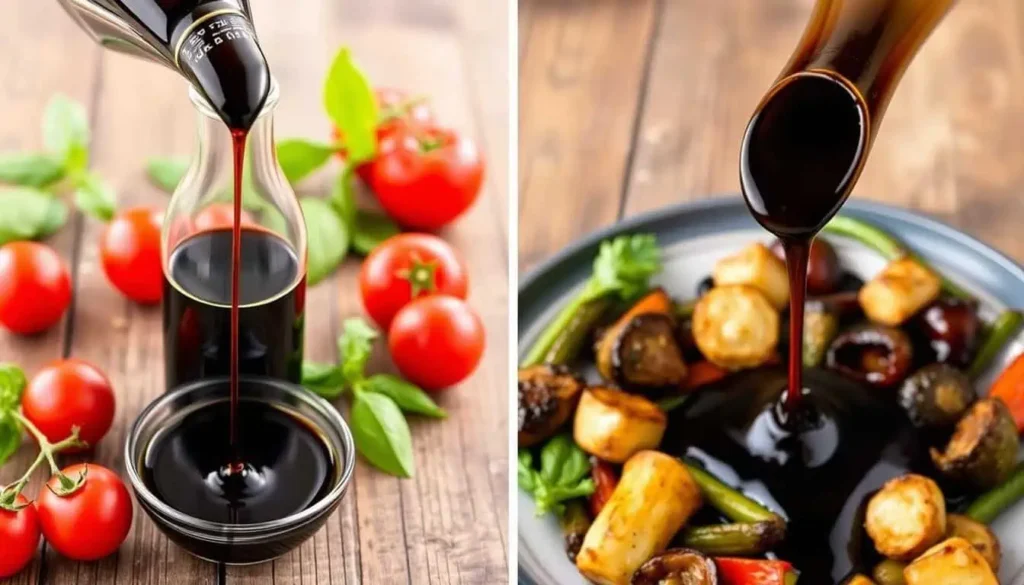Ever wondered why some recipes use balsamic vinegar and others balsamic glaze? It’s a question many ask. I’m here to explore the world of these two ingredients. They both have unique tastes, but they’re used differently in cooking.
In this section, I’ll explain the main differences. I’ll show you how each can make your dishes better.
Key Takeaways
- Learn how to distinguish between liquid and glaze products.
- Understand their textures, flavors, and culinary uses.
- Find tips to enhance your recipes.
Understanding Balsamic Vinegar
Balsamic vinegar is known for its rich taste and many uses in cooking. It comes from Italy and is made from grape juice. The aging in wooden barrels makes it special, adding depth to food.
Knowing the different types of balsamic vinegar helps you pick the best for your recipes. If you’re curious about how balsamic vinegar enhances dishes, discover what it does to a sauce for more insights.
What is Balsamic Vinegar?
Balsamic vinegar comes from Italy, mainly from Modena. It’s made by fermenting grape juice and aging it in wooden barrels. This process makes it sweet and tangy, unlike other vinegars.
It can be thin and sharp or thick and syrupy. This makes it great for many dishes.
Types of Balsamic Vinegar
There are two main types of balsamic vinegar: Traditional Balsamic Vinegar of Modena and Balsamic Vinegar of Modena PGI. The traditional one is aged for at least 12 years and tastes richer. It’s found in specialty shops and is pricier.
Balsamic Vinegar of Modena is more common and affordable. It’s good for everyday cooking.
Best Uses for Balsamic Vinegar
Balsamic vinegar is great for many things. I love using it in salad dressings for its sweetness. Here are some of my top uses:
- Drizzling it over fresh fruits like strawberries or peaches for a tasty dessert
- Marinating meats and vegetables to boost their flavor
- Adding a splash to sauces for a richer taste
- Using it as a finishing touch on cheeses and charcuterie boards
Want to elevate your chicken dishes with vinegar? Find out what vinegar does to chicken when cooking and how it changes the texture and flavor.
For easy recipes, mix balsamic vinegar with olive oil, garlic, and herbs. It makes a great dipping sauce or glaze.

Understanding Balsamic Glaze
Balsamic glaze is a thick, sweet sauce made from balsamic vinegar. It adds a rich flavor to many dishes. I love drizzling it over salads, grilled veggies, or even desserts. Making balsa glaze can make my cooking better and impress my guests.
If you’re looking for a practical recipe, why not try this balsamic chicken recipe that perfectly showcases the use of balsamic glaze?
What is Balsamic Glaze?
Balsa glaze is made by cooking down balsamic vinegar until it thickens. This process makes the vinegar’s flavor stronger. It also adds a sweetness from ingredients like brown sugar or honey.
Balsamic Glaze Ingredients
To make balsa glaze, I use a few key ingredients. These include:
- Balsamic vinegar
- Brown sugar or honey (for sweetness)
- Salt (to taste)
How to Make Balsamic Glaze
Making balsa glaze is easy and doesn’t take much time. Here’s a simple recipe I often follow:
- Pour 1 cup of balsamic vinegar into a saucepan.
- Add 1-2 tablespoons of brown sugar or honey, depending on your sweetness preference.
- Cook over medium heat, stirring occasionally, until the mixture reduces by half and thickens.
- Allow it to cool before transferring it to a storage container.

What is the difference between balsamic and balsamic glaze?
Understanding the difference between balsa vinegar and balsa glaze is key. It’s not just about cooking terms. The main difference lies in their flavors and textures. These differences affect how I use them in my recipes.
Balsamic Vinegar vs Balsamic Glaze: Flavor Profiles
When choosing between balsamic vinegar and balsamic glaze, flavor is the first thing to consider. Balsamic vinegar has a sharp acidity and natural sweetness. It’s great for adding a refreshing touch to salads and marinades.
Balsamic glaze, on the other hand, is sweeter and thicker. It’s made by reducing the vinegar, making it perfect for drizzling over dishes or as a dip.
Consistency and Texture Comparison
The texture of balsamic vinegar and balsamic glaze is also important. Balsamic vinegar is a liquid, great for dressings and sauces. It mixes well with other ingredients.
Balsamic glaze, however, is thicker, like a syrup. This makes it stick to food, perfect for garnishing and adding flavor to dishes.
Culinary Uses for Balsamic Vinegar and Balsamic Glaze
Balsamic vinegar and glaze add excitement to cooking. They make simple meals special. Using these gourmet condiments changes the game in the kitchen.
Curious about more sauce ideas? Discover what balsamic vinegar does to a sauce and find new ways to enhance your meals.
Balsamic Vinegar Uses in Cooking
Balsamic vinegar is more than just for salad dressings. It’s great in marinades for meats, adding flavor to chicken, beef, or pork. It’s also perfect in dips, mixing well with cheese and veggies.
Adding balsamic vinegar to sautéed veggies makes them pop. It brings out their natural flavors and adds a tangy twist.
Balsamic Glaze Uses in Dishes
Balsamic glaze is a kitchen staple. It’s amazing on a caprese salad, balancing the flavors of mozzarella and tomatoes. It also makes roasted meats shine, adding a glossy finish.
Even desserts benefit from balsamic glaze. It’s a sweet surprise on ice cream or fruit compote, elevating the taste.
Looking for a recipe that uses glaze? Check out this balsamic chicken recipe to get inspired.
Food Pairings with Balsamic Products
Exploring pairings with balsamic products is fun. It pairs well with cheeses like Parmesan or goat cheese. Fruits like strawberries and pears also complement it, balancing sweetness and acidity.
Chocolate fans will love balsamic glaze on dark chocolate desserts. It adds a luxurious touch, making it a must-have in any gourmet pantry.
Find out what balsamic vinegar does to a sauce to learn more pairing ideas for your dishes.
| Ingredient | Balsamic Vinegar Uses | Balsamic Glaze Uses |
|---|---|---|
| Salads | Vinaigrettes, Marinades | Drizzling, Garnishing |
| Meats | Marinades, Sauces | Glazing, Finishing Touch |
| Vegetables | Sautéing, Roasting | N/A |
| Desserts | N/A | Drizzling, Pairing with Ice Cream |
| Cheese | Pairing | Garnishing |
Balsamic Reduction vs Balsamic Glaze
Exploring balsamic products means knowing the difference between balsamic reduction and glaze. They share some traits but have distinct uses. I love using both in my cooking for different effects.
How are They Different?
Balsamic reduction is vinegar that’s been boiled down to thicken. This makes its flavor stronger but can be more acidic. On the other hand, balsamic glaze mixes vinegar with sweeteners. It’s sweeter and thicker, perfect for adding depth to dishes.
Similarities between Balsamic Reduction and Glaze
Despite their differences, balsamic reduction and glaze have a lot in common. They’re both great for garnishing and can make any dish better. They’re perfect with salads, meats, and even desserts. Using either adds a special touch to my meals.
Finding Alternatives
Having the right ingredients is key when cooking. Sometimes, I need a balsamic vinegar or glaze substitute. Luckily, there are many alternatives that work well in different recipes.
Balsamic Vinegar Substitute
Red wine vinegar mixed with a bit of sugar is a good substitute. It captures the sweet-tart taste of balsamic vinegar. Apple cider vinegar is also great, with its fruity notes.
A little honey can add sweetness, making it taste like balsamic vinegar.
Balsamic Glaze Substitute Options
Teriyaki sauce is a sweet alternative to balsamic glaze. It has a deep flavor. Making your own glaze by simmering soy sauce with sugar and vinegar is another option.
These substitutes can make dishes taste great without losing the essence of balsamic glaze.
Conclusion
Knowing the difference between balsamic vinegar and balsamic glaze is key to better cooking. Balsamic vinegar adds a tangy flavor to salads, marinades, and dressings. On the other hand, balsamic glaze is sweeter and thicker. It’s perfect for drizzling over meats, veggies, and even desserts.
Both are crucial in Italian cooking but for different reasons. By trying both, I’ve found they’re super versatile. They can make any dish more flavorful, whether used alone or together.
For more creative ideas, try this balsamic chicken recipe to see how balsamic glaze can be used to enhance your meals.
FAQ
What is the difference between balsamic vinegar and balsamic glaze?
Balsamic vinegar is a thick, dark vinegar with a complex flavor. It’s great for dressings and marinades. Balsamic glaze, on the other hand, is sweeter and syrupy. It’s perfect for drizzling over dishes.
How is balsamic glaze made?
To make balsamic glaze, cook balsamic vinegar until it thickens. Sometimes, brown sugar or honey is added. This makes it sweeter and syrupy.
Can balsamic vinegar be used in recipes?
Yes! Balsamic vinegar is very versatile. You can use it in salad dressings, marinades, or as a flavor enhancer in many dishes.
What are the best foods to pair with balsamic glaze?
Balsamic glaze goes well with many foods. Try it with roasted meats, caprese salads, or even desserts like berries and ice cream. It adds a gourmet touch.
Is balsamic reduction the same as balsamic glaze?
No, they’re similar but not the same. Balsamic reduction is more acidic and doesn’t have sweeteners. Balsamic glaze, however, has sweeteners and is thicker.
What can I use as a substitute for balsamic vinegar?
If you’re out of balsamic vinegar, try mixing red wine vinegar or apple cider vinegar with a bit of sugar. This will give you a similar taste.
How can I make my own balsamic glaze?
To make balsamic glaze, simmer balsamic vinegar until it reduces by half. You can add a sweetener for extra flavor. Let it cool before using.
What is the ideal consistency of balsamic glaze?
Balsamic glaze should be syrupy. It should drizzle easily over dishes but hold its shape.
What are some unique uses for balsamic glaze in cooking?
Balsamic glaze is great for many uses. Try drizzling it over grilled vegetables, enhancing cheese platters, or as a topping for pizzas and roasted potatoes.

